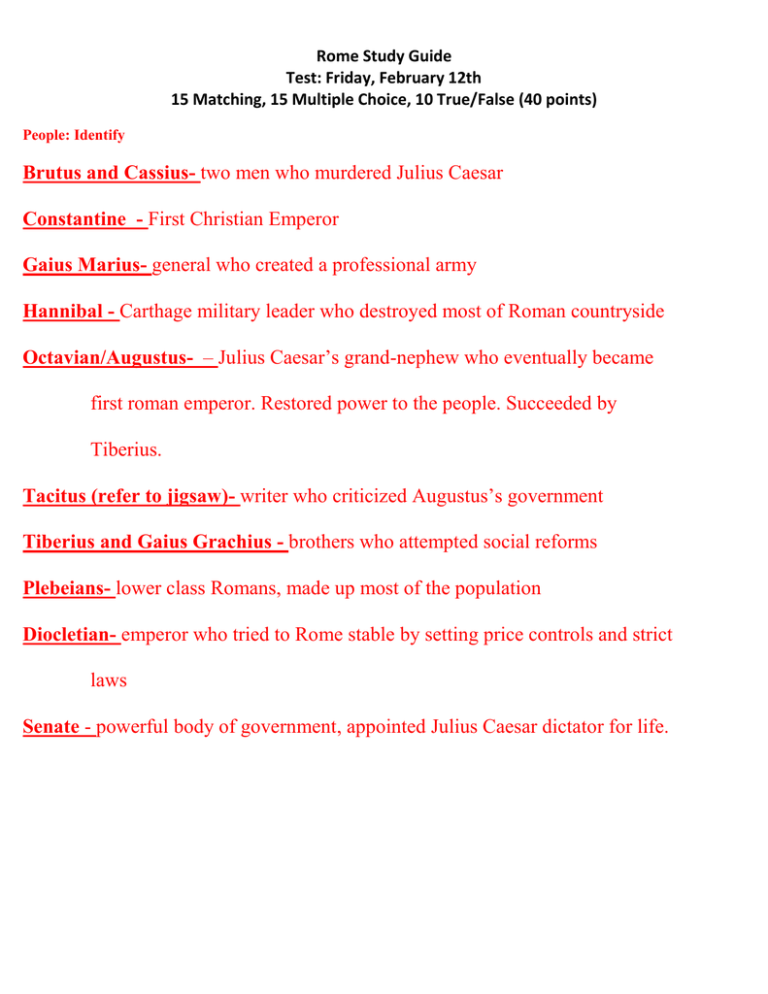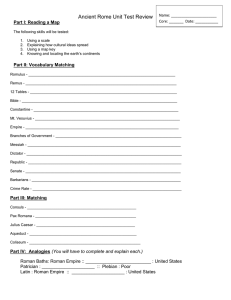Tacitus (refer to jigsaw)
advertisement

Rome Study Guide Test: Friday, February 12th 15 Matching, 15 Multiple Choice, 10 True/False (40 points) People: Identify Brutus and Cassius- two men who murdered Julius Caesar Constantine - First Christian Emperor Gaius Marius- general who created a professional army Hannibal - Carthage military leader who destroyed most of Roman countryside Octavian/Augustus- – Julius Caesar’s grand-nephew who eventually became first roman emperor. Restored power to the people. Succeeded by Tiberius. Tacitus (refer to jigsaw)- writer who criticized Augustus’s government Tiberius and Gaius Grachius - brothers who attempted social reforms Plebeians- lower class Romans, made up most of the population Diocletian- emperor who tried to Rome stable by setting price controls and strict laws Senate - powerful body of government, appointed Julius Caesar dictator for life. Rome Study Guide Test: Friday, February 12th 15 Matching, 15 Multiple Choice, 10 True/False (40 points) Terms: Define Aqueducts- bride-like structures that carried water from the mountains Arianism- Christianity belief that believes the three members of Trinity are unequal. Christianity- monotheistic religion that helped unite the Roman Empire Inflation- rise in prices due to devalued money Latin (refer to jigsaw)- language used at most medieval universities Monotheism- a belief/worship in only one god Paganism- The Roman state religion Pax Romana- time of durable Roman peace Polytheistic- a belief/worship in more than one god Know the significance of: Battle of Adrianople- Rome lost, frequent Germanic invasions began Battle of Actium (Octavian reading) – Octavian defeats Mark Antony. Octavian becomes sole ruler. Relationship between economic conditions and security: When the economy of one country/nation is in a crisis, citizens are more likely to revolt Number of Romans who were slaves: a large fraction Rome Study Guide Test: Friday, February 12th 15 Matching, 15 Multiple Choice, 10 True/False (40 points) Questions: Why did many Romans have to move to the cities? (Civil War Reading) Farmland was destroyed Who did the engraving of Roman laws on the Twelve Tables benefit and why? The plebeians because they could no longer be taken advantage of the patricians. Which of Caesar’s reforms are still used today? (Caesar Reading) The Roman Calendar What did Caesar do to the Senate? (Caesar Reading) Decrease their power What is the Eastern half of the Rome Empire known as? What happened to it after the west fell? The Byzantine Empire. It survived for a 1,000 years after the west fell. What were advances in Roman construction and engineering? (Refer to jigsaw) Concrete, the dome and arch, and aqueducts What were two key factors in the collapse of the western half of the Roman Empire? Inflation and increasing insecurity Rome Study Guide Test: Friday, February 12th 15 Matching, 15 Multiple Choice, 10 True/False (40 points) Why did the Christian church have great success? (Textbook) Their ability to organize What were Diocletian’s policies to reform the empire? (Textbook/Notes) Restricted individual freedom, stricter law, price and wage controls. What nationality were most Roman Army leaders by the end of the empire? German What is the difference between the Edict of Milan and the Edict of Sophia? (Rise of Christianity Reading) Edict of Milan- legalized Christianity throughout the Roman Empire. Edict of Sophia- legalized Christianity only in the eastern roman empire.





